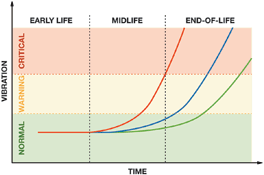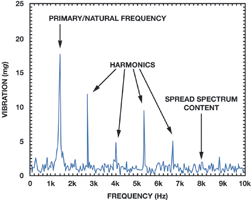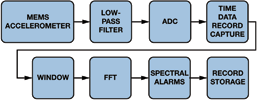
Their small size, low power, ease of integration, high level of functionality and superb performance encourage and enable innovation in gadgets such as smartphones, gaming controllers, activity trackers and digital picture frames. In addition, they have substantially improved reliability and reduced cost in automotive safety systems, allowing them to be deployed in most automobiles.
The continuous advancement in functional integration and performance has also helped MEMS accelerometers and gyroscopes find their way into many different industrial systems. Some of these applications offer lower-cost alternatives to present products and services, while others are integrating inertial sensing for the very first time.
Vibration monitoring is emerging as an application that has both types of users. Traditional instruments that monitor machine health for maintenance and safety often use piezoelectric technology. High-speed automation equipment monitors vibration to trigger feedback control of lubrication, speed or belt tension, or to shut down equipment for quick attention from maintenance staff.
Although piezoelectric devices have a mature user-base, MEMS accelerometers offer easy integration and reduced cost to an emerging group of new users. In addition, their advanced functional integration allows devices – such as Analog Devices’ ADIS16229 digital MEMS vibration sensor with embedded RF transceiver – to provide a complete solution including signal processing and communications.
This type of programmable device can wake itself up periodically, capture time-domain vibration data, perform a fast Fourier transform (FFT) on the data record, apply user-configurable spectral analysis to the FFT result, offer simple pass/fail results over an efficient wireless transmission, provide access to data and results, and then go back to sleep.
New adopters of vibration sensing are finding that quick deployment and the reasonable cost of ownership are good reasons to evaluate fully integrated MEMS devices.
Vibration monitoring applications
When using vibration to observe machine health, the objective is to correlate observable vibration with typical wear-out mechanisms such as bearings, gears, chains, belts, brushes, shafts, coils and valves. In a typical machine, at least one of these mechanisms requires regular maintenance.

Figure 1 shows three examples of the vibration vs time relationship for a normal wear-out mechanism. Although it takes time and experience to develop this type of relationship, a well correlated vibration signature can be a cost-saving alternative to regular maintenance that follows short cycle times. Using actual observations, such as vibration, provides an opportunity to take quick action when warning conditions are detected (red curve), while avoiding premature maintenance on machines that have more life remaining (blue and green curves).
Figure 1 also shows two alarm settings (warning, critical) and three stages of the machine’s maintenance cycle (early, middle, end). The warning level defines the maximum vibration during normal operation, where the observed vibration contains no indication of potential hazard for the machine or support staff. When in the normal range, some instruments can support infrequent vibration measurements.
The critical level indicates that the asset is at risk of severe damage, creating unsafe conditions for support staff or the environment. Obviously, machine operators want to avoid operation at this level, and typically take the machine offline. When vibration is above the warning level but below the critical level, the machine can still perform its task but should be observed more frequently and may likely require additional maintenance.
Sometimes, these three zones of operation (normal, warning, critical) can correlate to the three stages of a machine’s maintenance cycle (early life, midlife, end-of-life) in which case they may influence the vibration monitoring strategy.
For example, during early life, an instrument might only require daily, weekly or monthly observation of key vibration attributes. As it moves into midlife, this might change to hourly observation, and as it approaches end-of-life, vibration monitoring might occur even more often, especially in cases where people or the asset are at risk.
At this stage, machines that monitor vibration using portable equipment will accumulate recurring costs that might become prohibitive when compared to the cost of maintenance. While major assets can justify special attention, many other instruments cannot bear the recurring cost. To complement manual measurements, embedded MEMS-based sensors provide a more cost-effective approach for equipment that requires real-time vibration data.
Nature of vibration
Vibration is a repetitive mechanical motion. A number of attributes are important for developing a vibration sensing instrument. First, an oscillating motion often has both linear and rotational components. Most vibration sensing relationships tend to focus on the magnitude of the oscillation, not on absolute position tracking, so linear sensors such as MEMS accelerometers are sufficient for capturing motion information.
When the motion is mostly linear, understanding the direction can be important, especially when using single-axis sensors. Conversely, a three-axis sensor can offer more mounting flexibility, as the orthogonal orientation enables pickup on one or more axes regardless of the vibration direction.

Since vibration is periodic, spectral analysis offers a convenient way to characterise the vibration profile (the relationship between vibration magnitude and frequency). The profile shown in Figure 2 has both broadband and narrowband components, with primary vibration at ~1350 Hz, four harmonics, and some low-level wideband content. Every piece of moving equipment will have its own vibration profile, with the narrowband response often representing the natural frequencies of the equipment.
Signal processing
The sensor selection and signal processing architecture depends on the application’s objectives. As an example, the signal chain shown in Figure 3 continuously monitors a specific frequency band, providing warning and critical lights on a nearby control panel.

The manufacturer’s insight into the mechanical design aids with the bandpass filter design, specifically with the start frequency, stop frequency and passband roll-off rates. Rotation speed, natural frequencies of the mechanical structure, and fault-specific vibration behaviours can all influence the bandpass filter.
While this type of approach is simple, vibration monitoring requirements can change as historical data from a particular machine becomes available. Changes in monitoring requirements can lead to changes in the filter structure, which can present a recurring engineering cost.
Developers can trade complexity for flexibility by digitising the sensor response, implementing key signal processing functions such as filter, rms computation and level detectors, and leveraging auxiliary I/O outputs to control indicator lights or provide a numerical output.

Figure 4 shows a signal chain for the ADIS16228, which uses a digital tri-axial vibration sensor with FFT analysis and storage to monitor the spectral content of equipment vibration.
The second half of this article will appear in the next issue of Dataweek, and will delve into the technical features critical to an effective vibration monitoring solution – not only the motion sensor core itself, but also essential integrated features.
For more information contact Kevin Godfrey, Arrow Altech Distribution, +27 (0)11 923 9600, [email protected], [email protected]
| Tel: | +27 11 923 9600 |
| Email: | [email protected] |
| www: | www.altronarrow.com |
| Articles: | More information and articles about Altron Arrow |

© Technews Publishing (Pty) Ltd | All Rights Reserved